For some, gardening might be a mere hobby, but for me, it’s an artistic expression and a gateway to a world of wonders. You see, I’ve always been a bit unconventional in my gardening approach. I don’t settle for the usual suspects. Instead, I thrive on variety, and that’s precisely why I’ve made up my mind to explore the world of flowers that start with G.
While roses and daisies have their charm, I find myself irresistibly drawn to the allure of the lesser-known blooms. Hence, my money is on flowers that start with the letter G.
Without further ado, here’s a list of flowers that start with letter G.
24 Flowers That Start With G
1. Gerbera – Cheerful and Charming
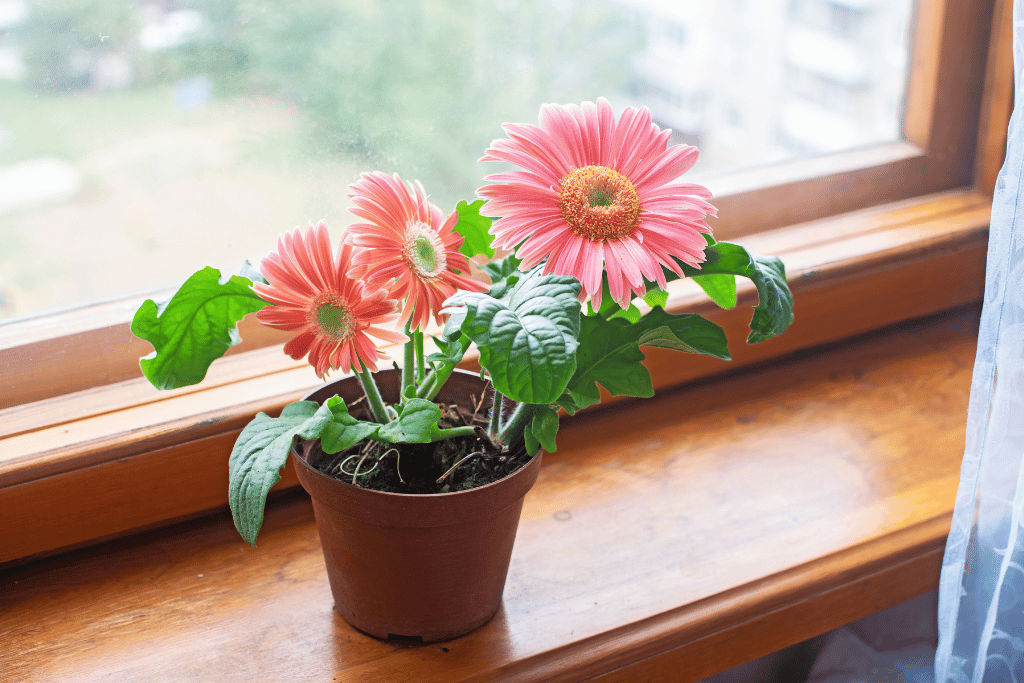
Gerbera daisies are the epitome of cheerfulness and charm. These delightful flowers, native to South Africa, come in a vivid array of colors, from bold reds and yellows to soft pastels. They have a unique shape with large, round flower heads and contrasting centers.
As one of the most popular cut flowers, Gerberas are frequently used in bouquets to convey joy and positivity. Their bright and sunny appearance makes them a favorite for various occasions, including birthdays, anniversaries, and get-well wishes.
To cultivate Gerberas successfully, it is crucial to provide them with well-draining soil and ample sunlight. They are also relatively low-maintenance, making them an excellent choice for both beginner and experienced gardeners alike.
2. Globe Amaranth – Everlasting Beauty
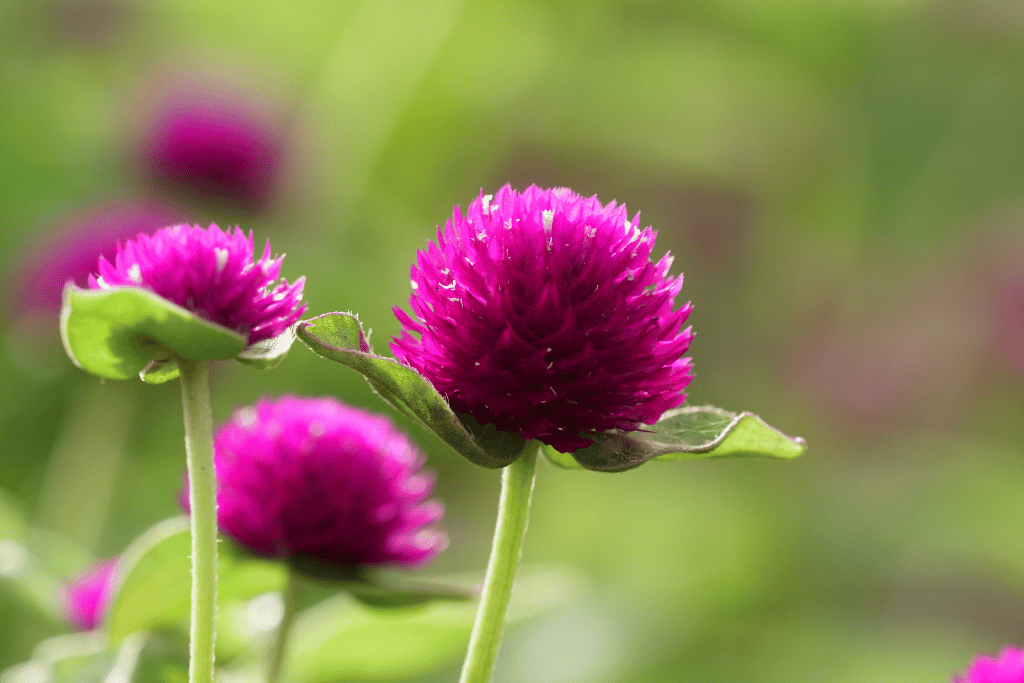
With their long-lasting blooms and attractive appearance, Globe Amaranths are a popular choice for both ornamental and functional purposes. Whether adorning a garden bed or gracing a floral arrangement, these enchanting flowers are sure to add a touch of charm and fascination.
Globe Amaranth, also known as Gomphrena, is a captivating flower with everlasting beauty. Native to Central and South America, these globe-shaped blooms come in a variety of colors, including shades of pink, purple, and white. The Globe Amaranth’s papery flowers maintain their color even when dried, making them perfect for crafting dried flower arrangements.
Additionally, their ability to withstand heat and drought makes them a dependable option for gardeners in hot and arid areas.
3. Gladiolus – Majestic Stalks of Grace
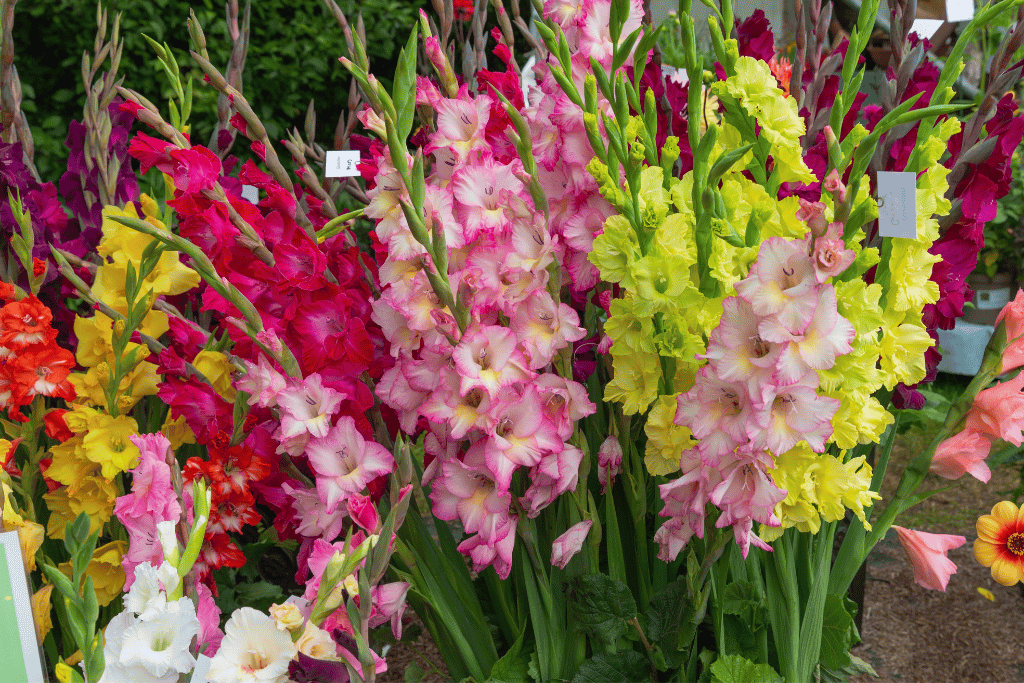
Gladiolus, often referred to as Glads, are majestic flowering plants that produce tall, graceful stalks adorned with multiple colorful blooms. Available in a wide spectrum of colors, Gladiolus flowers can create stunning visual displays in gardens and floral arrangements. Native to Africa, these plants are famous for their sword-shaped leaves and impressive vertical presence. They are also a popular choice for events and celebrations, adding a touch of elegance and splendor to any occasion.
To grow healthy Gladiolus, it is essential to provide them with well-draining soil and full sun exposure. Their impressive height and striking appearance make them stand out in any landscape, captivating the hearts of gardeners and flower enthusiasts alike.
4. Goldenrod – A Bright Symbol of Autumn
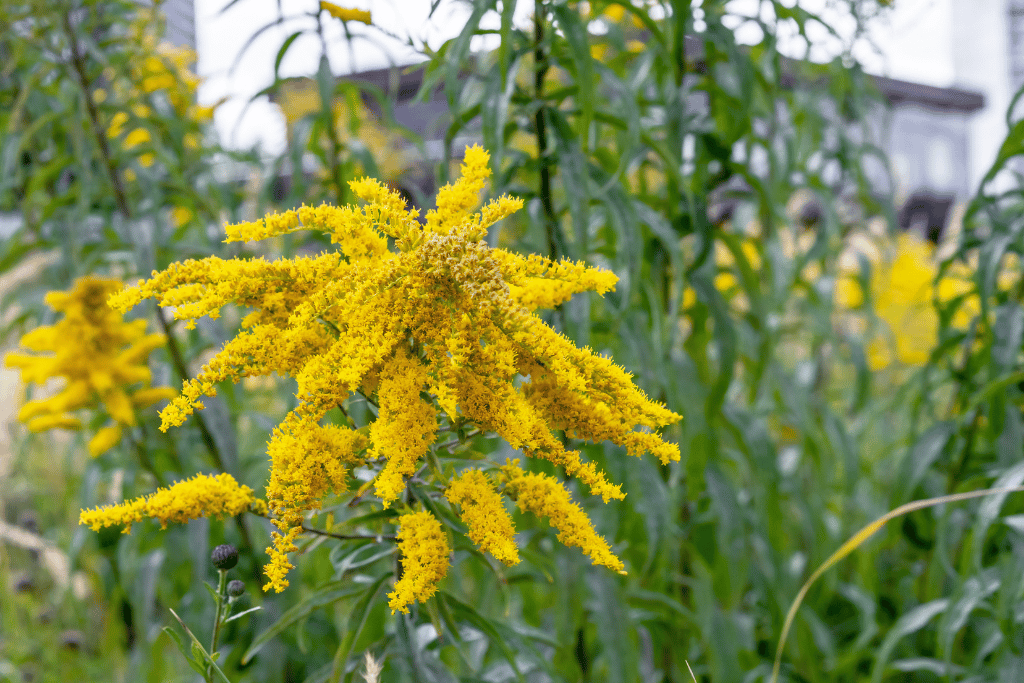
Goldenrod is a bright and cheerful flower that start with G, a symbolizes the arrival of autumn. Native to North America, these tall, vibrant blooms are known for their golden-yellow inflorescences, which attract bees, butterflies, and other pollinators.
Beyond their ecological importance, these flowers add a warm and welcoming touch to autumn landscapes, creating a golden spectacle that brightens up the transition from summer to fall. Goldenrods thrive in sunny locations with well-drained soil and are often seen in meadows, prairies, and roadside plantings.
Contrary to popular belief, Goldenrod is not a significant cause of seasonal allergies; its pollen is heavy and less likely to be airborne. Instead, it provides a vital source of nectar for late-season pollinators, making it an essential component of the ecosystem.
5. Gaillardia – Sun-Kissed Beauty for Pollinators
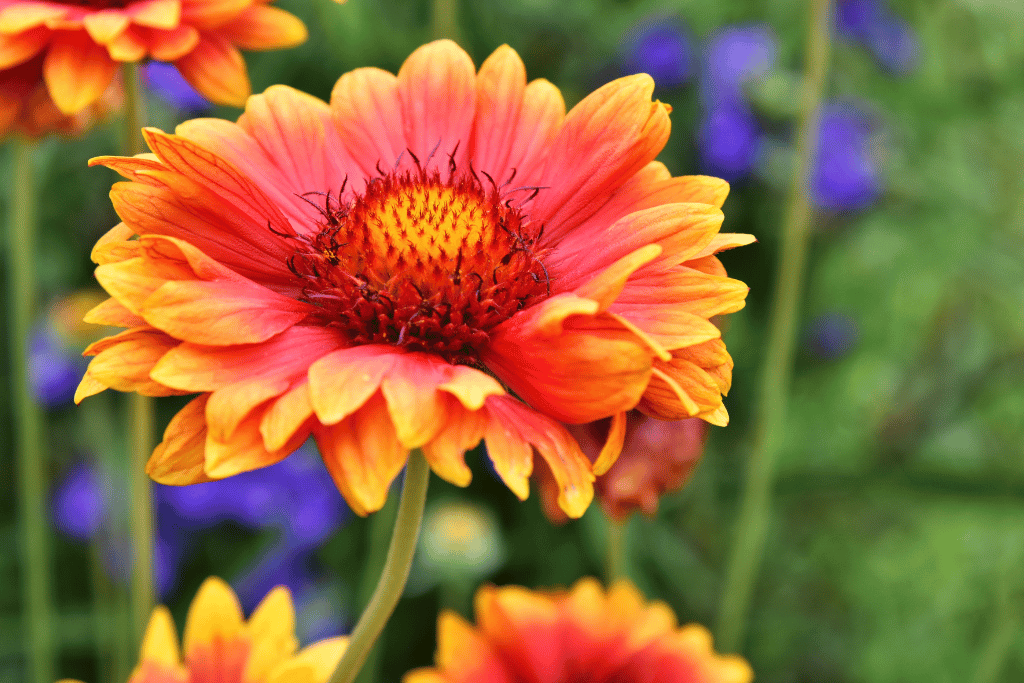
Gaillardias are relatively low-maintenance and can tolerate poor soil, making them a great addition to any garden. With their striking colors and ability to attract pollinators, Gaillardias contribute not only to the beauty of the landscape but also to the overall health of the ecosystem.
This beauty queen, also known as Blanket Flower, is a sun-kissed beauty adored by gardeners and pollinators alike. With their vibrant and daisy-like flowers, Gaillardias offer a colorful tapestry of red, orange, and yellow hues, resembling a cozy blanket.
These hardy perennials are native to North and South America and are well-suited for hot and dry conditions, making them a popular choice for xeriscaping. Moreover, their nectar-rich blooms attract butterflies, bees, and other beneficial insects, adding life and movement to the garden.
6. Gazania – Sun-Loving Dazzling Beauties
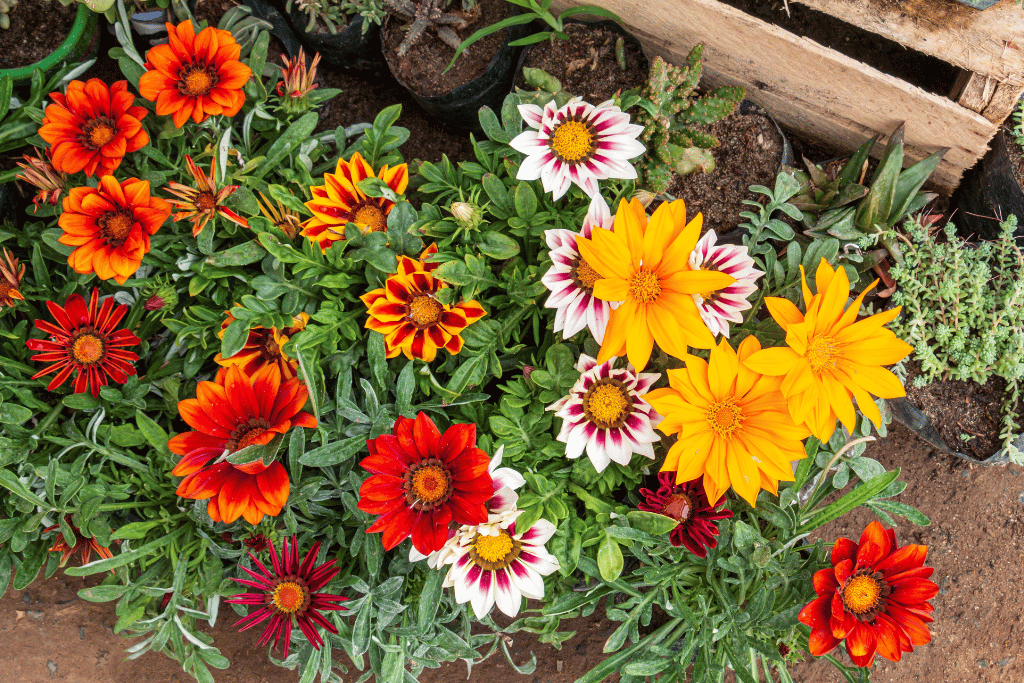
Gazanias are sun-loving and drought-tolerant flowers originating from South Africa. With their striking and vibrant petals that resemble rays of the sun, they bring a burst of color to gardens and landscapes. Gazanias come in various shades, including shades of orange, pink, yellow, and white.
These hardy perennials are perfect for sunny and hot climates, thriving in well-draining soil with minimal water requirements. Their ability to withstand challenging conditions makes them a popular choice for low-maintenance gardens and rockeries.
Gazanias are known to close their petals during the evening and open them again with the first rays of the sun, making them a captivating flower to observe throughout the day.
7. Gentian – Exquisite Elegance in Shades of Blue
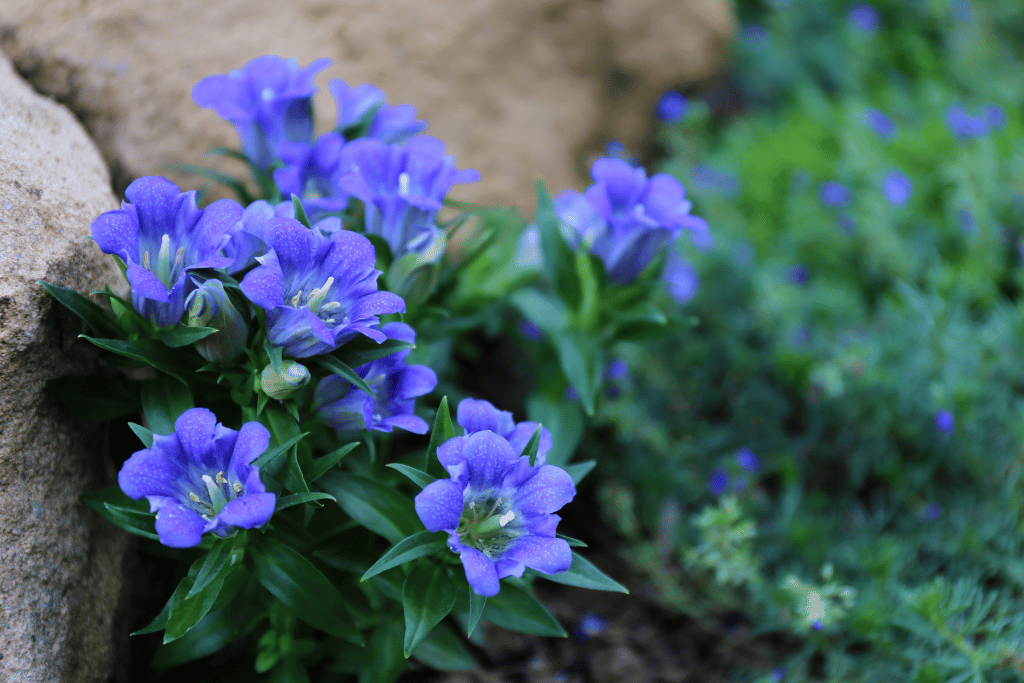
Gentians, trumpet-shaped blossoms are native to alpine and mountainous regions, showcasing their hardiness and adaptability. These are exquisite and elegant flowers renowned for their striking shades of blue, although they can also be found in white, purple, and pink hues.
Gentians are often associated with symbolism of purity, grace, and love. They add a touch of elegance and sophistication to gardens, particularly when grown in rock gardens or alongside water features.
Due to their preference for cool and moist conditions, Gentians may require extra care and attention in warmer climates. However, their unparalleled beauty and captivating presence are well worth the effort for gardeners seeking to create a truly enchanting landscape.
8. Glory Lily – Tropical Sensation
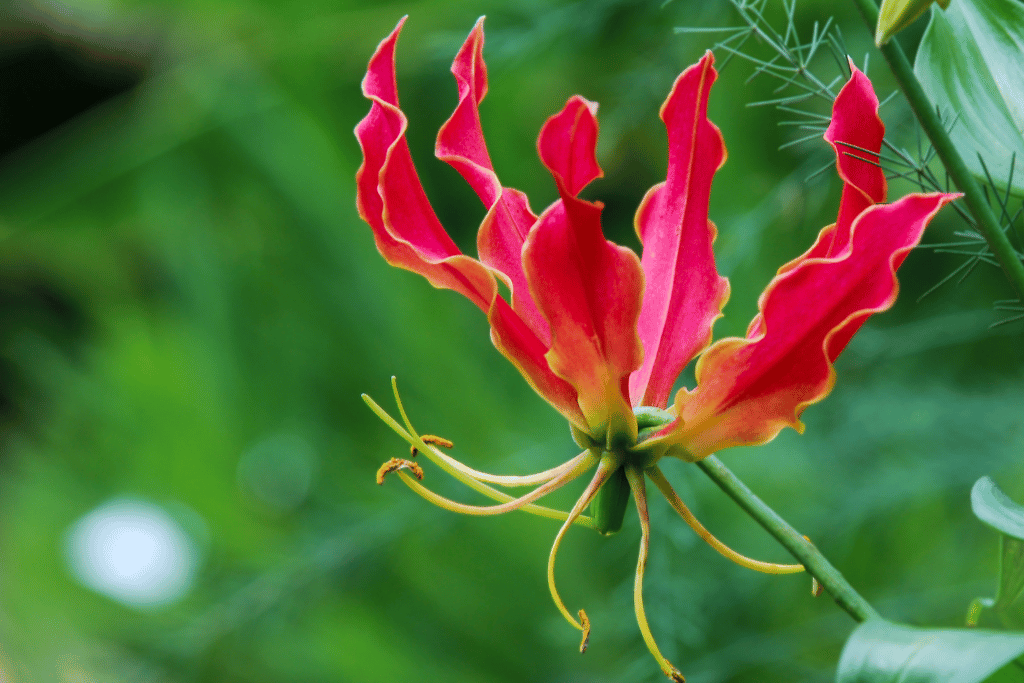
Glory Lilies are popular in tropical gardens and can be grown in containers with support structures or trellises. They prefer full sun and well-draining soil, and they require protection from frost. They are also referred to as Gloriosa, a dazzling tropical flower that commands attention with its striking, flame-like petals. Native to Africa and parts of Asia, this climbing vine produces stunning blooms in shades of red, orange, and yellow with distinctively curved and pointed tepals.
These exotic flowers are also known for their unique and unusual growth habit, climbing and twining their way up fences, walls, or other plants. Their eye-catching appearance and tropical allure make them a captivating addition to any garden seeking a touch of drama and vibrancy.
9. Godetia – Graceful Blooms in Pastel Tones
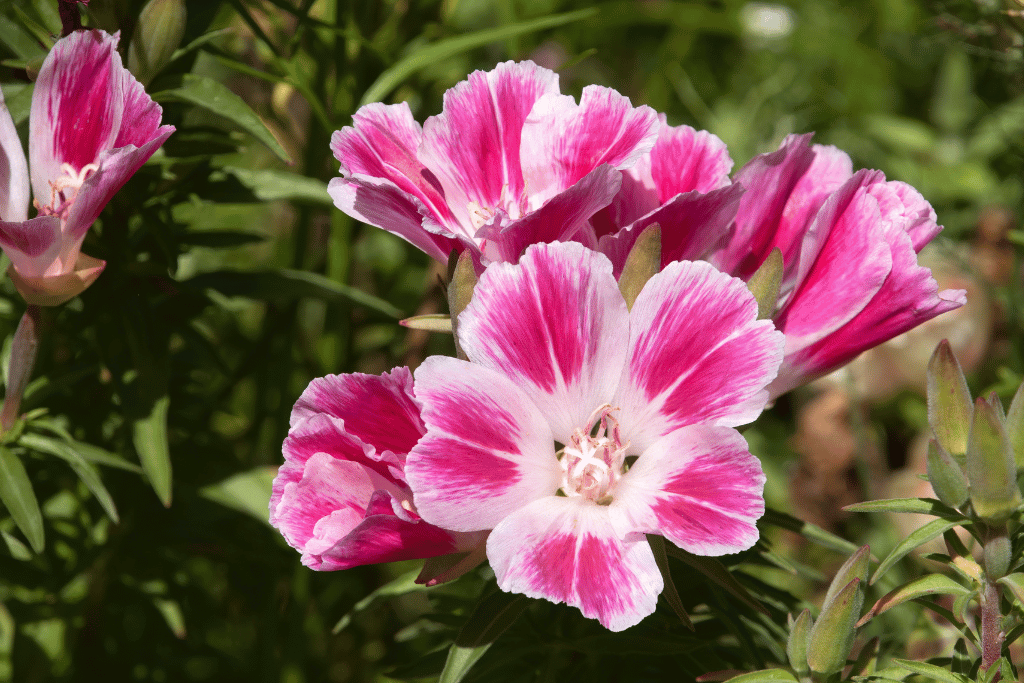
Godetia, also called Farewell to Spring, is a delicate and charming flower native to western North America. With its cup-shaped blooms in soft pastel shades of pink, lavender, and white, Godetia brings a sense of grace and tranquility to gardens. These annuals are easy to grow from seeds and are well-suited for borders, containers, or wildflower meadows. They prefer cool temperatures and thrive in well-draining soil with regular watering.
Godetias are attractive to pollinators like bees and butterflies, making them a valuable addition to pollinator-friendly gardens. Their ethereal beauty and gentle demeanor add a touch of romantic elegance to any landscape or floral arrangement.
10. Gypsophila – Airy Clouds of Baby’s Breath

With its profusion of tiny, cloud-like blooms, Gypsophila is a popular choice for adding texture and lightness to floral arrangements and bouquets. Gypsophila, commonly known as Baby’s Breath, is a delicate and airy flower native to Europe, Asia, and North Africa. Whether gracing a wedding bouquet or adding charm to a cottage garden, Gypsophila’s delicate, white blooms evoke a sense of purity and innocence, creating an enchanting atmosphere wherever they bloom.
The traditional use of Gypsophila as a companion plant to roses has made it a symbol of everlasting love, making it a popular addition to wedding decorations and romantic settings. The delicate appearance of Gypsophila belies its hardiness; it can thrive in various conditions, including sandy or poor soil. It is a favorite among gardeners for its versatility, and it can be used as a border plant, ground cover, or filler in mixed plantings.
11. Ginger Lily – Exotic Fragrance and Tropical Beauty

Ginger Lily, native to Southeast Asia, these tall and elegant perennials produce clusters of showy, trumpet-shaped flowers in shades of white, pink, orange, and yellow. Beyond their aesthetic appeal, Ginger Lilies are admired for their delightful scent, reminiscent of a blend of jasmine and gardenia. They are often used in perfumes, essential oils, and traditional medicine.
These plants thrive in warm and humid climates, making them well-suited for tropical and subtropical regions. They prefer fertile, well-draining soil and partial shade. The beauty and fragrance of Ginger Lilies add an element of sophistication and luxury to any garden or indoor space, transforming it into an oasis of tropical splendor.
12. Golden Tulip – A Symbol of Wealth and Prosperity

Golden Tulip, also known as Tulipa Lutea, is a stunning and symbolic flower associated with wealth and prosperity. Native to the Mediterranean region, this rare and exquisite tulip variety showcases beautiful golden-yellow petals.
The Golden Tulip is highly valued among flower enthusiasts and collectors for its unique color and historical significance. It symbolizes luxury and opulence, making it a favorite in formal gardens and special occasions.
To cultivate Golden Tulips successfully, it is essential to provide them with well-draining soil and full sun exposure. These radiant blooms bring a touch of splendor and elegance to gardens, creating a visual spectacle that celebrates the beauty of nature.
13. Globe Thistle – A Sphere of Intriguing Blooms

Globe Thistle, scientifically known as Echinops, is an intriguing flower prized for its spherical blooms and unique appearance. Native to Europe and Asia, this hardy perennial forms globular clusters of spiky, steel-blue flowers that resemble captivating orbs.
Globe Thistles are cherished for their ability to attract pollinators, including bees and butterflies, making them a valuable addition to wildlife-friendly gardens. These striking flowers prefer well-draining soil and full sun exposure, thriving in a variety of garden settings, from cottage gardens to contemporary landscapes.
The architectural beauty and textural interest of Globe Thistles make them stand out in the garden, adding a sense of enchantment and allure to any floral arrangement or garden design.
14. Gaura – Graceful and Breezy Perennial

Gaura is drought-tolerant and prefers well-draining soil. Its airy appearance and long blooming season make it a valuable addition to perennial borders, rock gardens, and wildflower meadows. The flowers come in various shades, including white, pink, and bi-colored varieties, adding a touch of elegance to gardens and landscapes.
Gaura, commonly known as Whirling Butterflies or Wand Flower, is a graceful and breezy perennial native to North America. These delicate plants produce tall, wand-like stems adorned with small, star-shaped flowers that flutter in the breeze like dancing butterflies.
15. Gloxinia – Velvety Splendor
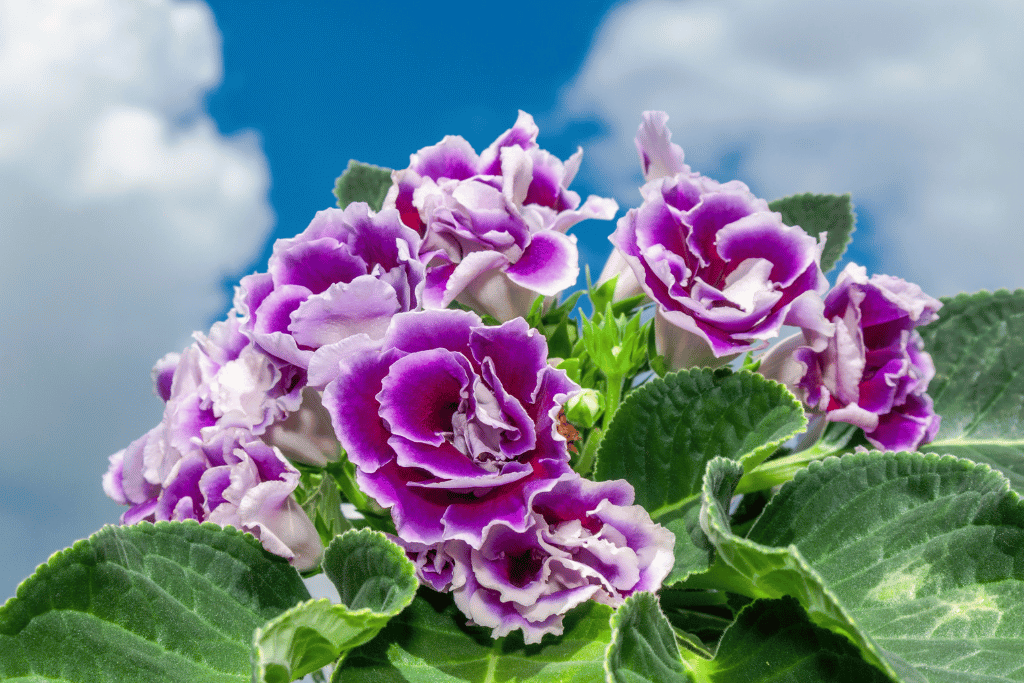
Gloxinias are typically grown as indoor houseplants or in protected outdoor environments with filtered light. They prefer well-draining soil and need to be kept consistently moist, making them a bit more demanding in terms of care. Despite their high-maintenance nature, the breathtaking beauty of Gloxinias makes them a prized possession among avid plant collectors and flower enthusiasts, adding a touch of elegance and refinement to any living space.
Gloxinia, also known as Sinningia, is a plant admired for its velvety and luxurious flowers. These beauty queens are native to South America, this tropical beauty produces trumpet-shaped blooms in an array of mesmerizing colors, including shades of purple, pink, and white, often adorned with intricate patterns.
16. Garden Phlox – A Carpet of Color
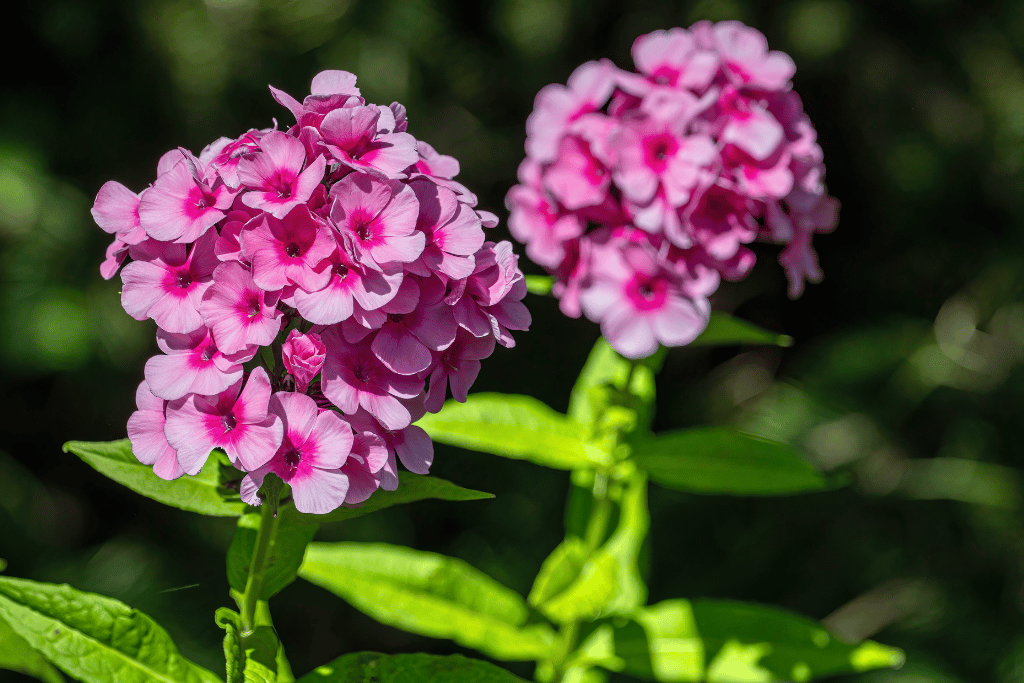
Phlox paniculata, commonly referred to as Garden Phlox, is an enchanting perennial plant that covers the garden in an abundance of vibrant flowers. Originating from North America, these scented blooms display a range of colors, such as pink, lavender, white, and red.
Garden Phlox is a popular choice for borders, cottage gardens, and pollinator-friendly landscapes, as its nectar-rich blooms attract butterflies and hummingbirds. This low-maintenance plant prefers well-draining soil and full sun exposure. With its impressive floral display and sweet fragrance, Garden Phlox creates a captivating and vibrant atmosphere that enchants both humans and wildlife alike.
17. Grape Hyacinth – A Charming Spring Delight
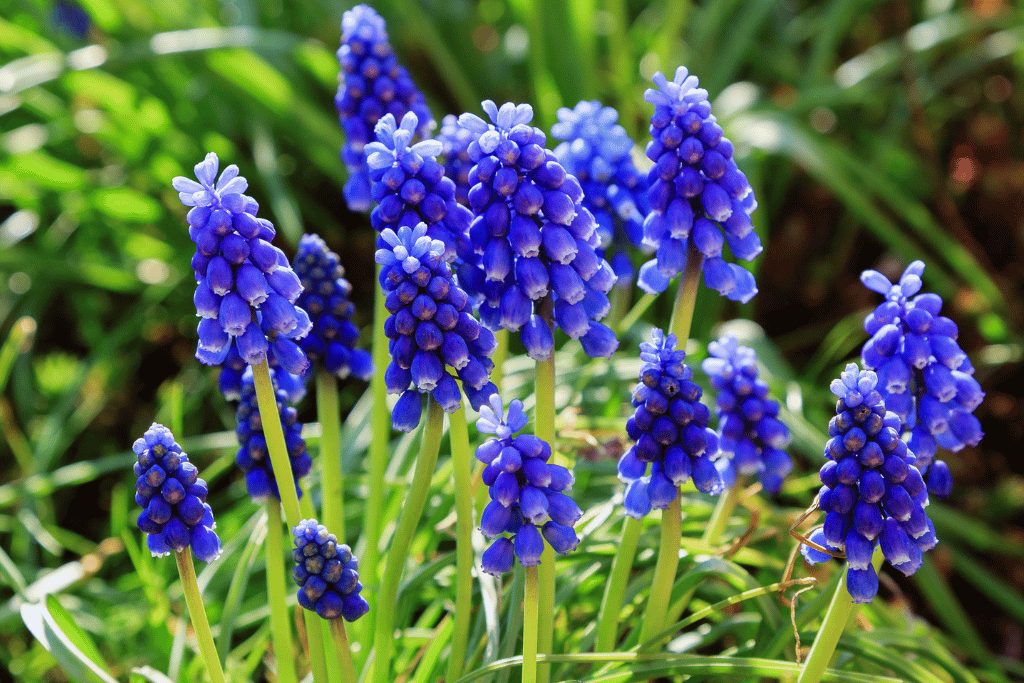
Grape Hyacinths are easy to grow and require minimal care. They prefer well-draining soil and can tolerate partial shade. Their ability to naturalize and multiply makes them a delightful addition to any spring garden, forming charming carpets of colorful blooms that evoke feelings of joy and renewal.
Grape Hyacinth, scientifically known as Muscari, is a charming and petite bulbous flower that graces gardens with its delightful presence. Native to Eurasia, these small blooms resemble tiny clusters of grapes, hence the name “Grape Hyacinth.”These spring-blooming flowers come in shades of blue, purple, and white, adding a touch of charm and whimsy to rock gardens, borders, and naturalized areas.
18. Geranium – Timeless Garden Favorite
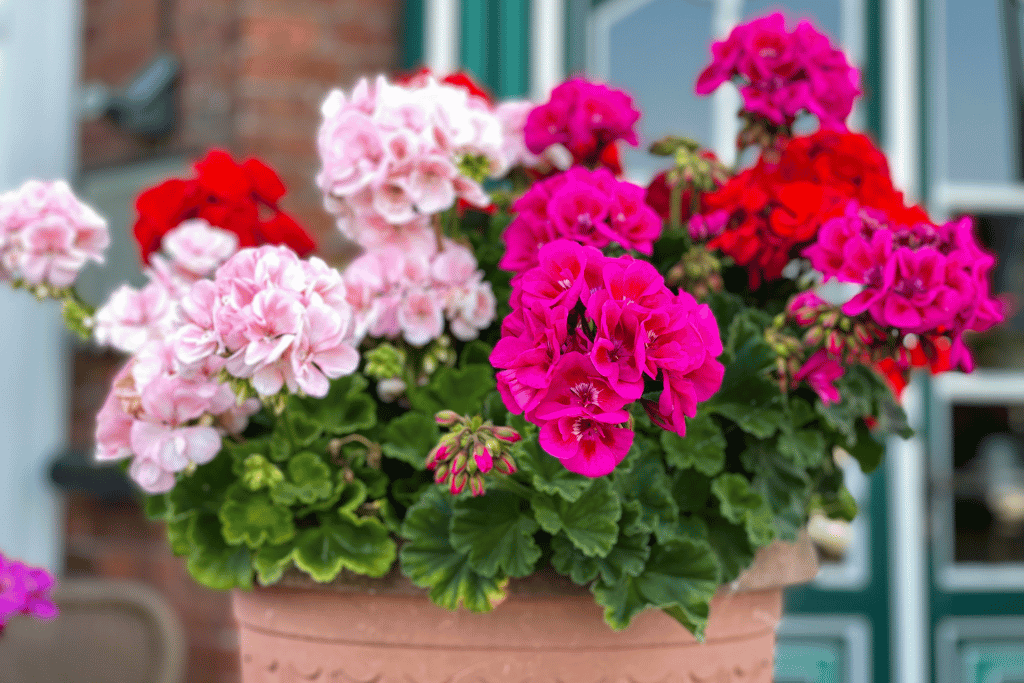
Geraniums are a timeless and beloved garden favorite known for their versatility and beauty. These flowering plants, native to various regions around the world, come in a wide range of colors, including shades of pink, red, purple, and white.
Geraniums are commonly grown in garden beds, containers, and hanging baskets, adding a burst of color to any outdoor space. They are also popular as indoor houseplants, brightening up windowsills and living areas with their vibrant blooms and attractive foliage.
With their low-maintenance nature and ability to thrive in various conditions, Geraniums are a go-to choice for gardeners of all levels of experience. Their classic charm and enduring popularity ensure that they remain a cherished addition to gardens for generations to come.
19. Golden Penda – A Glorious Canopy of Gold

The botanical name for the Golden Penda is Xanthostemon chrysanthus, and it is a captivating flowering tree indigenous to Australia. Its profuse clusters of vibrant, yellow-gold flowers come together to form a magnificent golden canopy, drawing admiration even from a distance. This perpetually green tree is an exceptional option for landscaping, particularly in regions with tropical and subtropical climates.
It flourishes in well-draining soil and under abundant sunlight. The blooms of the Golden Penda have a magnetic allure for various bird species and butterflies, making it a beloved choice among enthusiasts of wildlife. The allure of the Golden Penda transcends its flowering period; its glossy green leaves provide an appealing background throughout the year. Whether employed as a central focal point or planted in rows to establish a path of gold, this grand tree introduces an element of grandeur to any outdoor setting.
20. Geum – Dainty Blooms with Radiant Colors
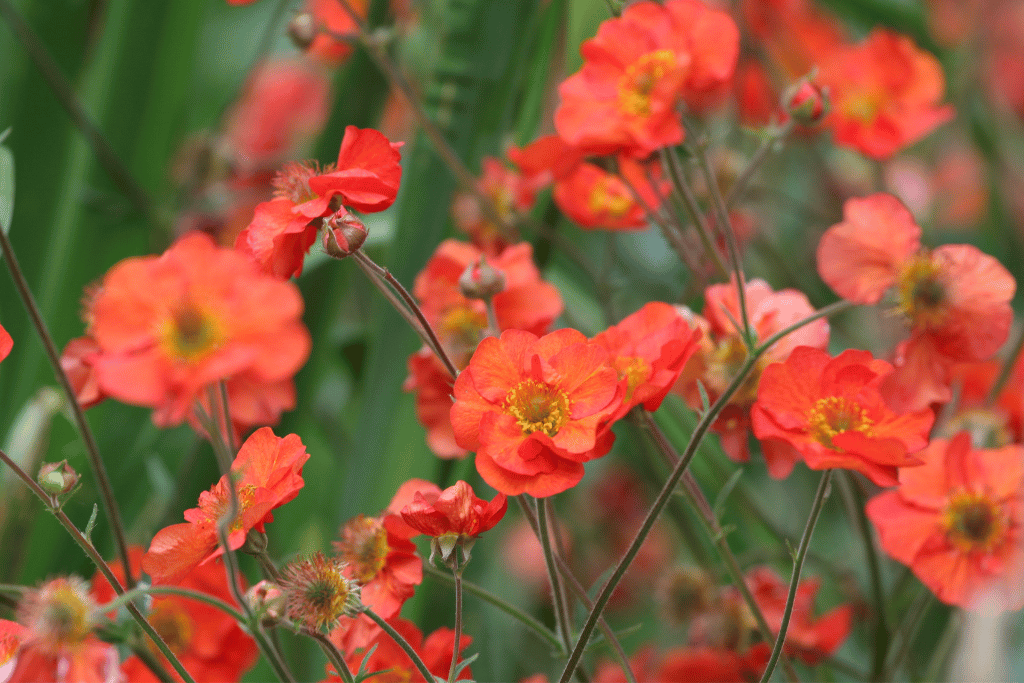
Geum, also known as Avens, is a charming and dainty perennial admired for its radiant flowers. Native to various regions around the world, Geum produces blooms in shades of yellow, orange, red, and pink, adding a splash of color to gardens. The delicate flowers of Geum resemble small roses or buttercups, and their long blooming season ensures a continuous display of color throughout the warmer months.
These easy-to-grow perennials prefer well-drained soil and partial to full sun exposure. They are perfect for cottage gardens, borders, and rockeries, attracting pollinators and adding a touch of beauty and elegance to any outdoor space.
21. Globe Daisy – Whimsical Pompoms of Cheer
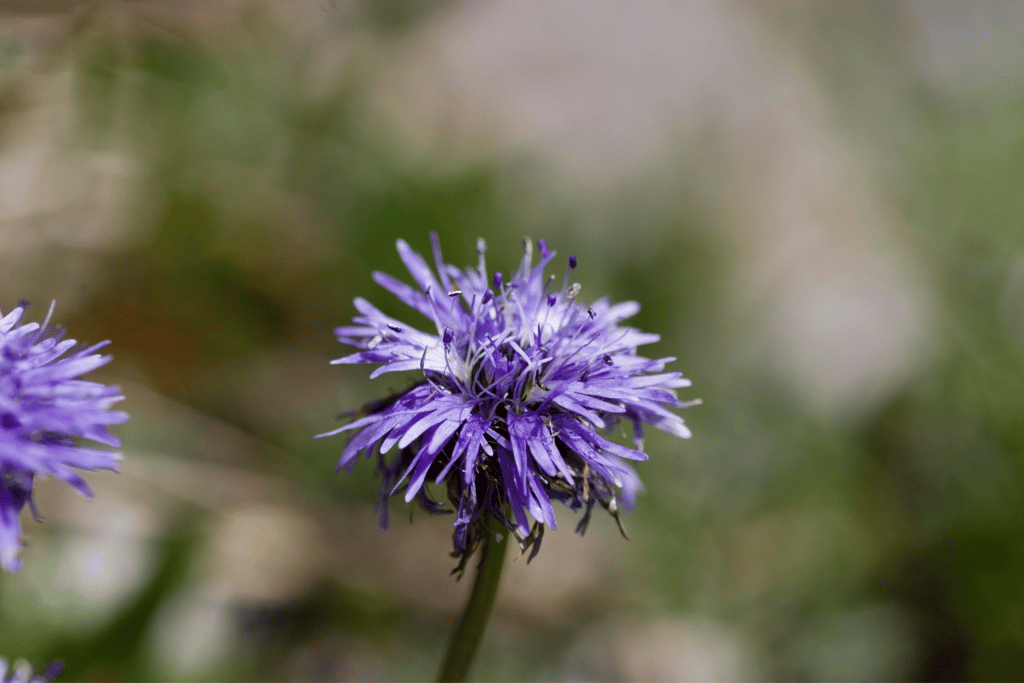
Globe Daisies are ideal for rock gardens, edging, and borders, as their neat and compact habit creates a neat and well-groomed appearance. These resilient perennials are drought-tolerant and prefer well-draining soil and full sun. Their unique and endearing appearance brings a touch of playfulness and enchantment to any garden or landscape, captivating the hearts of both young and old.
Globe Daisy, scientifically known as Globularia, is a whimsical and charming perennial adored for its cheerful pompom-like blooms. Native to Europe and North Africa, these low-growing plants produce compact clusters of rounded flowers in shades of blue, lavender, and white.
22. Guelder Rose – Nature’s Autumn Symphony
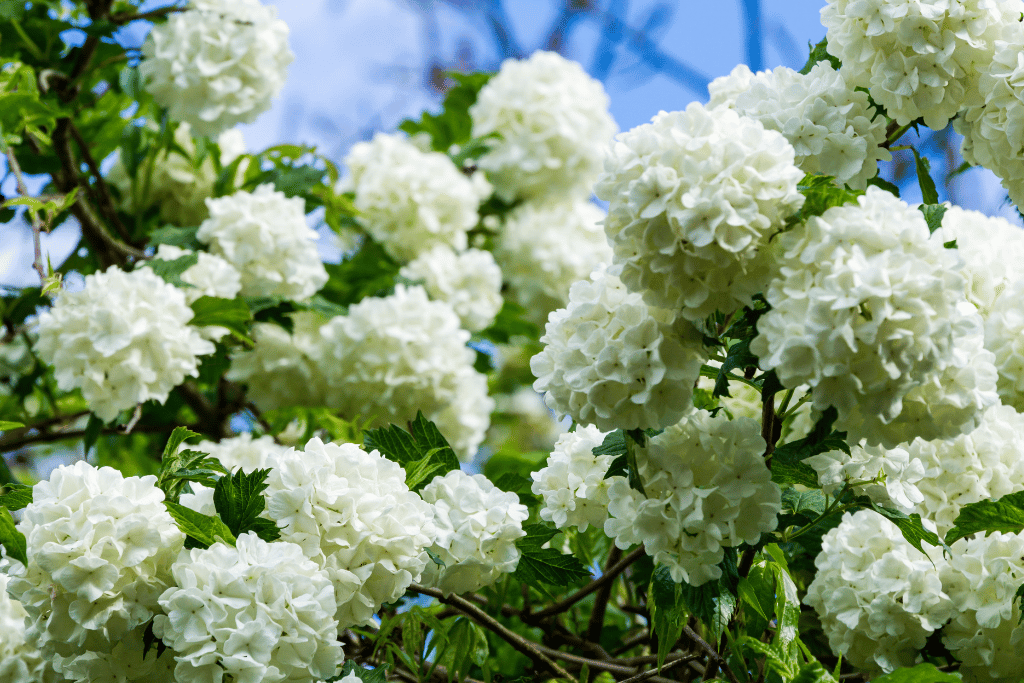
Guelder Rose prefers moist and well-drained soil and can be grown in full sun to partial shade. Its multi-season interest makes it a valuable addition to wildlife gardens and naturalized areas, providing food and shelter for various species.
Guelder Rose, commonly referred to as Viburnum opulus, is a deciduous shrub renowned for its stunning exhibition during the fall season. Originating from Europe, this shrub yields sizable bunches of crimson berries that create a striking contrast against its lively leaves, composing a symphony of autumnal beauty in nature. Apart from its autumn beauty, Guelder Rose also produces flat-topped clusters of white flowers in spring, attracting bees and butterflies.
23. Golden Trumpet – Nature’s Musical Masterpiece
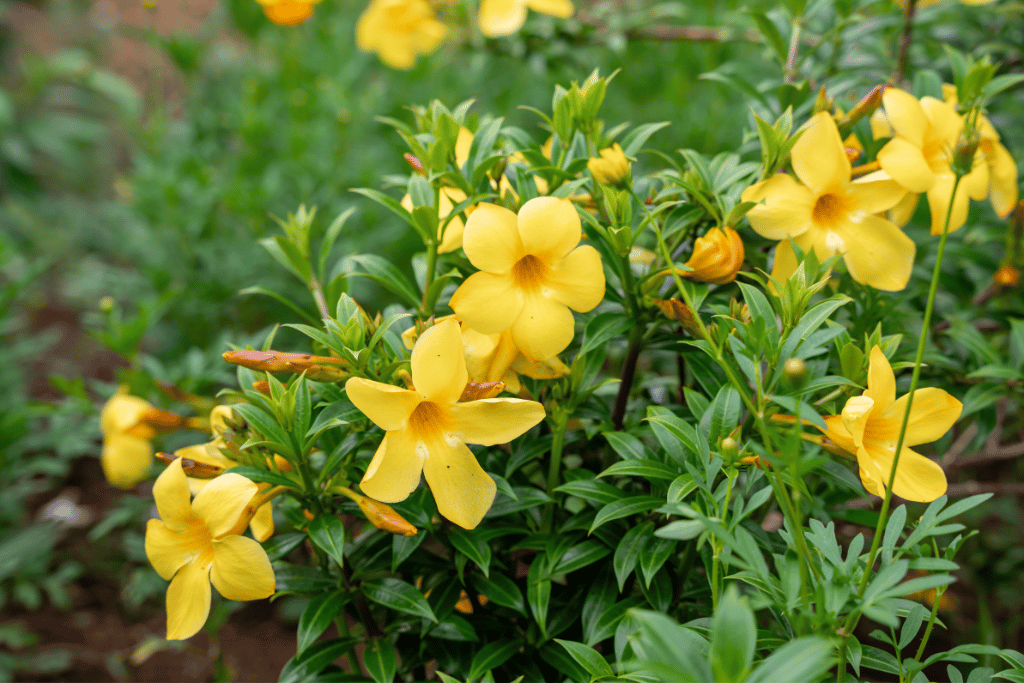
Originating from South and Central America, this robust climber has the ability to rapidly envelop walls, fences, and trellises. The tropical vine, scientifically labeled as Allamanda cathartica but commonly referred to as Golden Trumpet, is renowned for its splendid, trumpet-shaped flowers in a captivating golden-yellow hue.
The large, bell-shaped blooms of Golden Trumpet create a stunning visual display against its glossy green foliage. Its fragrant flowers, along with their distinct trumpet shape, earned it the common name “Golden Trumpet Vine.”
This show-stopping vine thrives in warm and humid conditions with well-draining soil and full sun exposure. Its captivating presence and melodious beauty add a touch of grandeur to tropical and subtropical gardens, attracting admiration and awe from all who encounter it.
24. Gerbera Daisy – Playful and Colorful Blooms

Gerbera Daisies are playful and colorful flowers that bring joy and cheer to gardens and floral displays. Native to South Africa, these daisy-like blooms come in an array of vibrant colors, including red, orange, yellow, pink, and white, often with contrasting centers.
Gerberas are a popular choice for cut flowers due to their long-lasting blooms and bold appearance. They add a touch of happiness and charm to bouquets and arrangements, making them a favorite for gifts and celebrations.
In the garden, Gerbera Daisies thrive in well-draining soil and full sun. They are ideal for borders, containers, and flowerbeds, where their playful petals and sunny disposition brighten up any landscape, reminding us to embrace life’s joyful moments.



